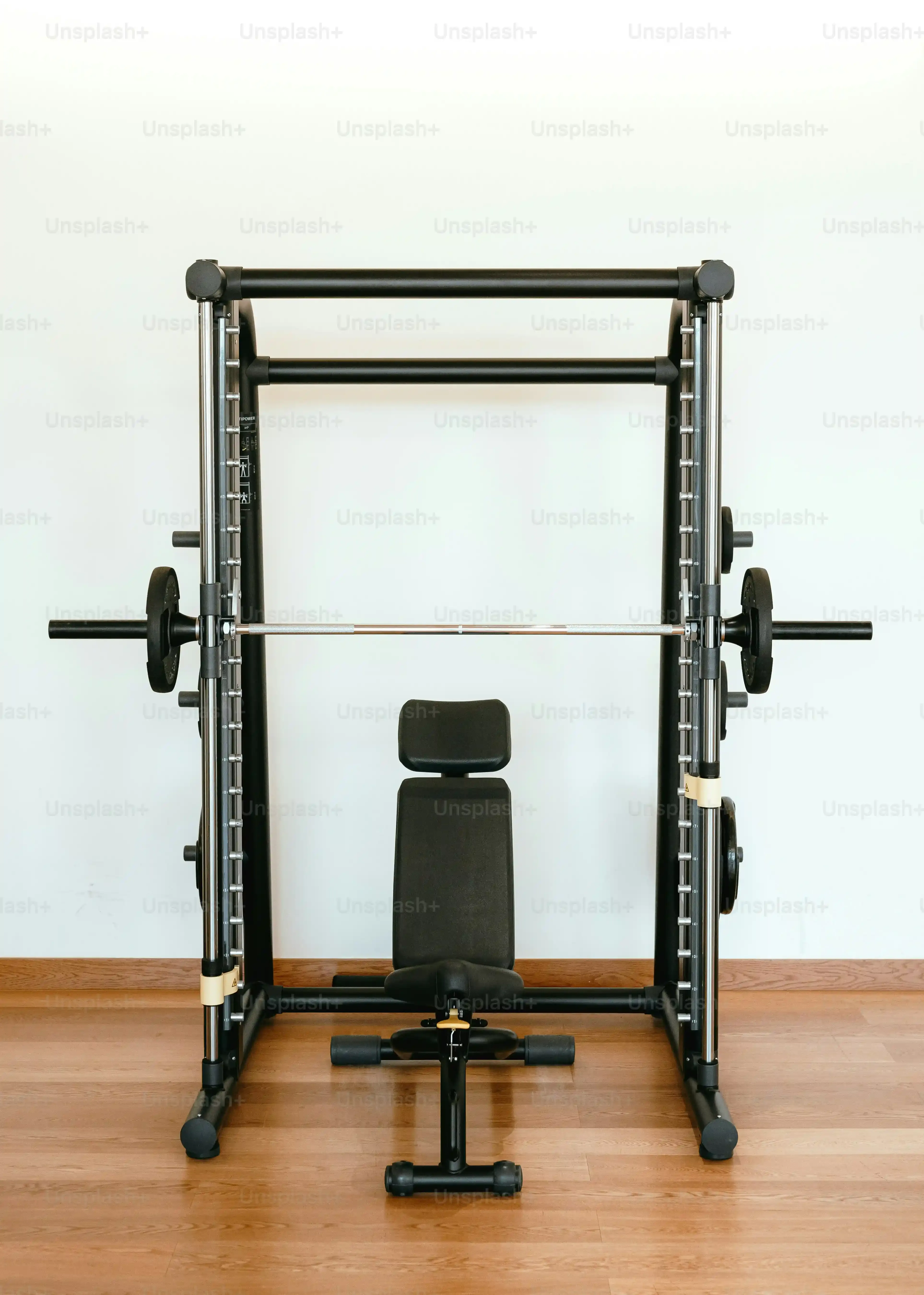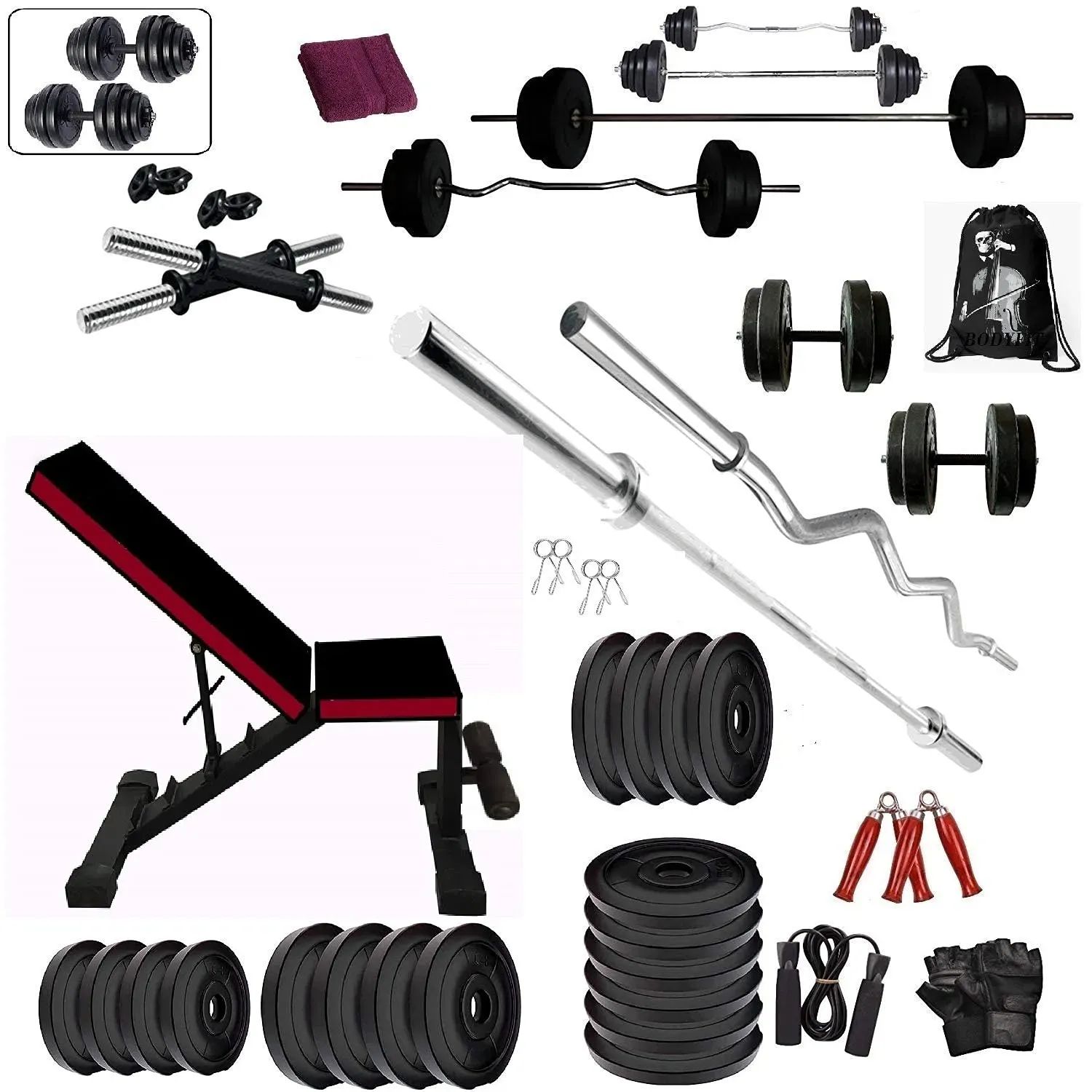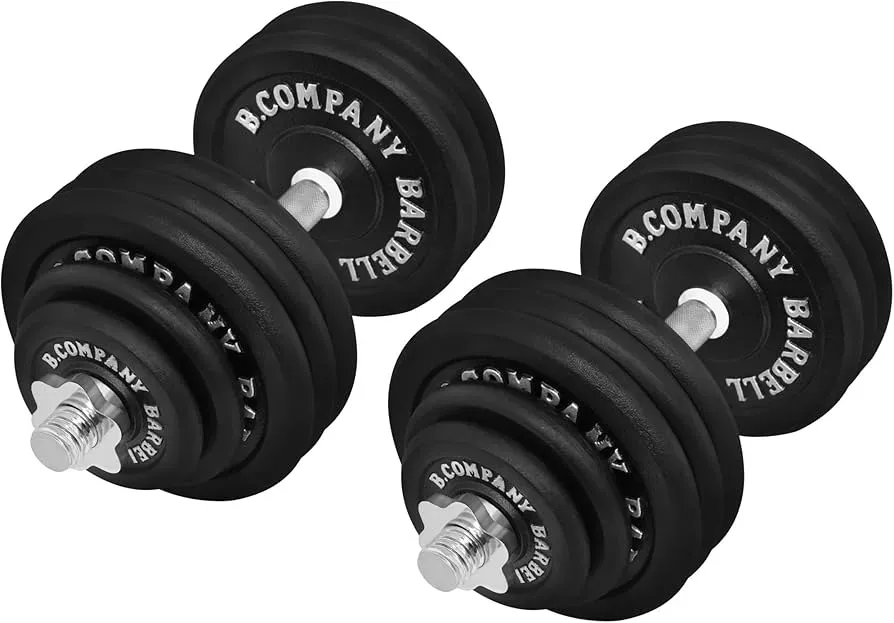Table of Contents
Tired of the commute to the gym? Sick of waiting for the squat rack while someone scrolls through TikTok? You're not alone. Building muscle and staying fit shouldn't feel like a second job. For many, the answer lies closer than they think: setting up a functional workout space right at home. But where do you start without turning your living room into a cluttered obstacle course? A smart move for beginners and intermediates looking to add serious strength training is often a well-chosen package. That's where a home gym set 80 kg comes into the picture. It's not some flimsy resistance band kit; we're talking about a legitimate amount of weight to challenge your muscles and drive real progress.
Why a Home Gym Set 80 kg is a Smart Start for Home Fitness
Why a Home Gym Set 80 kg is a Smart Start for Home Fitness
Ditching the Commute, Gaining Consistency
Look, nobody loves rush hour traffic or trekking across town just to lift some iron. That friction often kills motivation before you even start. Having a home gym set 80 kg eliminates that barrier entirely. Your workout is literally steps away. This isn't some abstract benefit; it directly translates to more consistent training sessions. When the weights are right there, staring you down, it's a lot harder to make excuses about the weather or how late you worked. You finish your day, change clothes, and you're lifting within minutes. That convenience is a superpower for building a regular fitness habit, far more effective than relying on willpower alone to get you out the door to a commercial gym.
Serious Capability Without Breaking the Bank (or Your Floor)
Gym memberships add up. Quick. And while a fully kitted-out home gym can cost a fortune, a targeted purchase like a home gym set 80 kg offers serious bang for your buck. You own the equipment outright. No recurring fees, no price hikes. Plus, 80 kg is a significant amount of weight for someone starting out or even at an intermediate level for many exercises. You can challenge yourself on squats, deadlifts, presses, and rows without needing a warehouse full of plates. It fits reasonably well into a spare room or even a corner of a garage, unlike massive multi-station machines that require dedicated space.
As a buddy of mine, who swore by his garage setup, once told me, "It’s not about having the fanciest gear, it’s about having the gear you'll actually use." An 80 kg set hits that sweet spot.
Common Reasons People Avoid Gyms:
- Lack of time due to commute
- Feeling intimidated by experienced lifters
- Waiting for equipment
- High monthly membership costs
- Privacy concerns
Enough Weight to Actually Build Strength
An 80 kg home gym set isn't just for show. This weight capacity, typically including a bar and plates, allows you to perform foundational compound movements that are key to building overall strength and muscle mass. Think squats, deadlifts, bench press, overhead press, and rows. You can load the bar progressively as you get stronger. For many beginners, 80 kg is more than enough to start with on these lifts and provides room to grow for quite some time. It's a practical weight threshold that supports real progress, unlike lighter sets that you'd outgrow in weeks.
What's Typically Included in a Home Gym Set 80 kg Package?
What's Typically Included in a Home Gym Set 80 kg Package?
The Core Components: Bar and Plates
Alright, so you're eyeing a home gym set 80 kg. What are you actually getting for your money? At its heart, an 80 kg set means 80 kilograms of total weight, usually distributed between a barbell and several weight plates. The barbell itself contributes to this weight, typically around 7 kg for standard bars or 20 kg for Olympic bars, though some starter sets might have lighter bars. The rest comes from the plates. You'll find a mix of sizes – maybe a couple of 10 kg plates, some 5 kg, and smaller ones like 2.5 kg or 1.25 kg. This variety is key, allowing you to make small jumps in weight as you get stronger, which is crucial for consistent progress.
Don't just look at the total number; look at the plate breakdown. Can you load 2.5 kg at a time, or are your smallest jumps 10 kg? Finer increments are better for avoiding frustrating plateaus.
Beyond the Iron: Accessories and Add-ons
While the bar and plates are the main event in a home gym set 80 kg, many packages throw in a few extras to sweeten the deal and increase versatility. Barbell collars are non-negotiable – they keep the plates from sliding off mid-lift and crushing your toes (or worse). You might also find a pair of dumbbell handles and matching plates, allowing you to switch between barbell and dumbbell exercises. Some more comprehensive 80 kg kits might even include a basic weight bench, expanding your exercise options significantly to include bench press and seated movements. Always check the exact contents list before buying; the phrase "80 kg set" can be interpreted slightly differently by various retailers.
Typical Items in an 80 kg Weight Set:
- Barbell (Standard or Olympic style)
- Weight Plates (various denominations adding up to 80 kg total weight, including the bar)
- Barbell Collars (Spring clips or screw collars)
- Possibly Dumbbell Handles
- Possibly additional smaller plates for dumbbells
- Less commonly, a basic weight bench
Workout Ideas You Can Crush with Your 80 kg Home Gym Set
Workout Ideas You Can Crush with Your 80 kg Home Gym Set
Mastering the Foundational Lifts
so you've got the iron. Now what? The beauty of a home gym set 80 kg is its ability to handle the big lifts – the ones that give you the most bang for your buck in terms of strength and muscle growth. We're talking squats, deadlifts, bench press, and overhead press. With 80 kg, you have ample weight to start learning the proper form and progressively challenge yourself. Don't jump straight to 80 kg on day one, obviously. Start light, focus on technique, and gradually add weight as you get stronger. This set provides the necessary resistance for building a solid foundation. These aren't just exercises; they're fundamental human movements loaded for resistance.
Performing these lifts consistently is the fastest way to see noticeable changes in your physique and overall strength. It's about compound movements that work multiple muscle groups simultaneously. A home gym set 80 kg makes these accessible without leaving your house.
Adding Variety and Targeting Muscles
While the big lifts are crucial, your home gym set 80 kg isn't limited to just those. You can easily incorporate variations and isolation exercises. Think Romanian deadlifts for hamstrings, barbell rows for your back, or push press for explosive shoulder power. If your set includes dumbbell handles, a whole new world opens up: dumbbell bench press, shoulder press, bicep curls, triceps extensions, lunges, and much more. Even exercises like barbell shrugs or calf raises become possible. The 80 kg total weight gives you enough plates to load both the barbell and dumbbells for different movements, allowing for a comprehensive full-body workout routine.
Having the ability to switch between barbell and dumbbell work, or perform variations like front squats instead of back squats, keeps your training fresh and helps target muscles from different angles. It prevents boredom and continues to challenge your body in new ways.
Key Exercises with an 80 kg Set:
- Barbell Back Squats
- Conventional Deadlifts
- Barbell Bench Press
- Overhead Press
- Barbell Rows
- Romanian Deadlifts
- Barbell Lunges
- Dumbbell Bench Press (if handles included)
- Dumbbell Shoulder Press (if handles included)
- Bicep Curls
Progression is King
The 80 kg weight isn't a finish line; it's a starting point with room to grow. As you get stronger, you'll add more weight to the bar or dumbbells. This progressive overload is the fundamental principle of strength training. Your home gym set 80 kg provides the plates to do this effectively for many exercises, especially during your initial months or even years of training. You track your lifts, aim to add a little weight or an extra rep each session, and watch your strength climb. It’s a measurable way to see your progress, which is incredibly motivating. Don't underestimate the power of consistently adding 1.25 kg or 2.5 kg plates; those small jumps accumulate into significant strength gains over time.
Choosing the Best Home Gym Set 80 kg: What to Look For
Choosing the Best Home Gym Set 80 kg: What to Look For
Barbell Type and Plate Quality Matter More Than You Think
so you've decided a home gym set 80 kg is the way to go. Now, how do you pick one that won't fall apart or annoy the heck out of you? The absolute first things to scrutinize are the barbell and the plates. Is it a standard bar (around 1-inch diameter) or an Olympic bar (2-inch diameter)? Olympic bars are generally sturdier, have rotating sleeves (which save your wrists during lifts like deadlifts), and accept standard Olympic plates, which are easier to find if you want to add more weight later. Standard sets are cheaper but less durable and harder to expand. For the plates, are they basic cast iron, rubber-coated, or bumper plates? Cast iron is classic and compact. Rubber-coated is quieter and protects floors a bit better. Bumper plates are thicker but designed to be dropped safely (though dropping 80 kg repeatedly might still annoy downstairs neighbors or crack cheap concrete). Check the bore size matches the bar!
Don't Skimp on Collars and Consider the Extras
Those little things that hold the plates on? They're called collars, and flimsy ones are a recipe for disaster. Spring clips are common in home gym set 80 kg packages, and they work okay, but screw collars are generally more secure, if a bit slower to change. If the set includes dumbbell handles, check their quality too – nobody wants a handle bending under load. Does the package include a bench? A basic flat bench or adjustable bench significantly expands the exercises you can do. If it does, check its weight capacity and stability. A wobbly bench is worse than no bench at all. Sometimes a slightly pricier home gym set 80 kg is worth it for better quality accessories that you won't have to replace immediately.
Key Factors When Comparing 80 kg Sets:
- Barbell Type (Standard vs. Olympic) and Weight
- Plate Material (Cast Iron, Rubber-Coated, Bumper)
- Plate Denominations (Allows for small weight jumps?)
- Type and Security of Barbell Collars
- Inclusion and Quality of Dumbbell Handles
- Bench Inclusion and Weight Capacity
- Overall Build Quality and Material Durability
Material Durability and User Reviews Tell the Real Story
Specs on a website are one thing, but how does the home gym set 80 kg actually hold up under regular use? This is where looking at the materials used and reading user reviews becomes critical. Is the bar solid steel or hollow tubing? Are the plates coated evenly, or will they chip and rust instantly? Check the weight capacity listed for the bar and any included bench – does it seem reasonable for the total weight? Don't just look at the star rating; read the comments. Do people complain about plates not fitting the bar, collars slipping, or rust appearing quickly? Real-world feedback from others who bought that specific home gym set 80 kg can save you a lot of headaches (and possibly stubbed toes) down the line. A little research here prevents buyer's remorse later.
Making the Most of Your 80 kg Home Gym Setup
Making the Most of Your 80 kg Home Gym Setup
Setting Up Your Space and Routine for Success
Having a home gym set 80 kg sitting in a corner is one thing; actually using it consistently and effectively is another. First off, dedicate a clear space. Even if it's just a 6x6 foot area, make it yours. Remove clutter, ensure good lighting, and maybe add a mat to protect your floor (and your ears if you drop anything). This dedicated zone signals to your brain that it's time to train. Second, schedule your workouts like appointments you can't miss. Whether it's before work, during lunch, or in the evening, block out the time. Consistency beats intensity when you're starting out or building a habit. Don't wait for motivation; rely on discipline derived from a set schedule. Your home gym set 80 kg is ready when you are, so remove the guesswork about *when* you'll train.
Optimizing Your Lifts and Progression with 80 kg
With an 80 kg home gym set, you have enough weight to perform core strength movements, but you need to use it smartly. Focus relentlessly on form before adding weight. Watch instructional videos, maybe even record yourself to check your angles on squats or deadlifts. Bad form with even 40 kg is asking for trouble, let alone 80 kg. Once your form is solid on a given lift, implement progressive overload. This means making the exercise harder over time. With 80 kg, this often means adding a small amount of weight (like 1.25 kg or 2.5 kg plates if your set allows) or doing more repetitions with the same weight. Don't try to add 10 kg every week; small, consistent increases are the sustainable path to strength. Track your lifts in a simple notebook or app – what weight did you use, how many reps did you do? This data is crucial for knowing when and how to progress.
As legendary coach Dan John puts it, "The goal is to keep the goal the goal." With a home gym set 80 kg, the goal is often foundational strength and muscle. Stay focused on that.
Strategies for Progression:
- Add 1.25kg or 2.5kg to the bar when you hit target reps.
- Perform more reps with the same weight.
- Do an extra set.
- Decrease rest time between sets.
- Improve lifting technique for better efficiency.
Your 80 kg Home Gym Set: It's Just the Beginning
So, you've weighed the options, maybe even pulled the trigger on a home gym set 80 kg. Good. You've got the foundation. This isn't a magic bullet; it's a tool. Consistency still matters. Lifting the weight, putting it down, repeating – that's the boring part that actually works. This set gives you the ability to skip the crowded gym and the questionable hygiene, but it won't lift itself. Now go put it to work. It's 80 kilograms of potential sitting in your space. What you do with it is up to you.